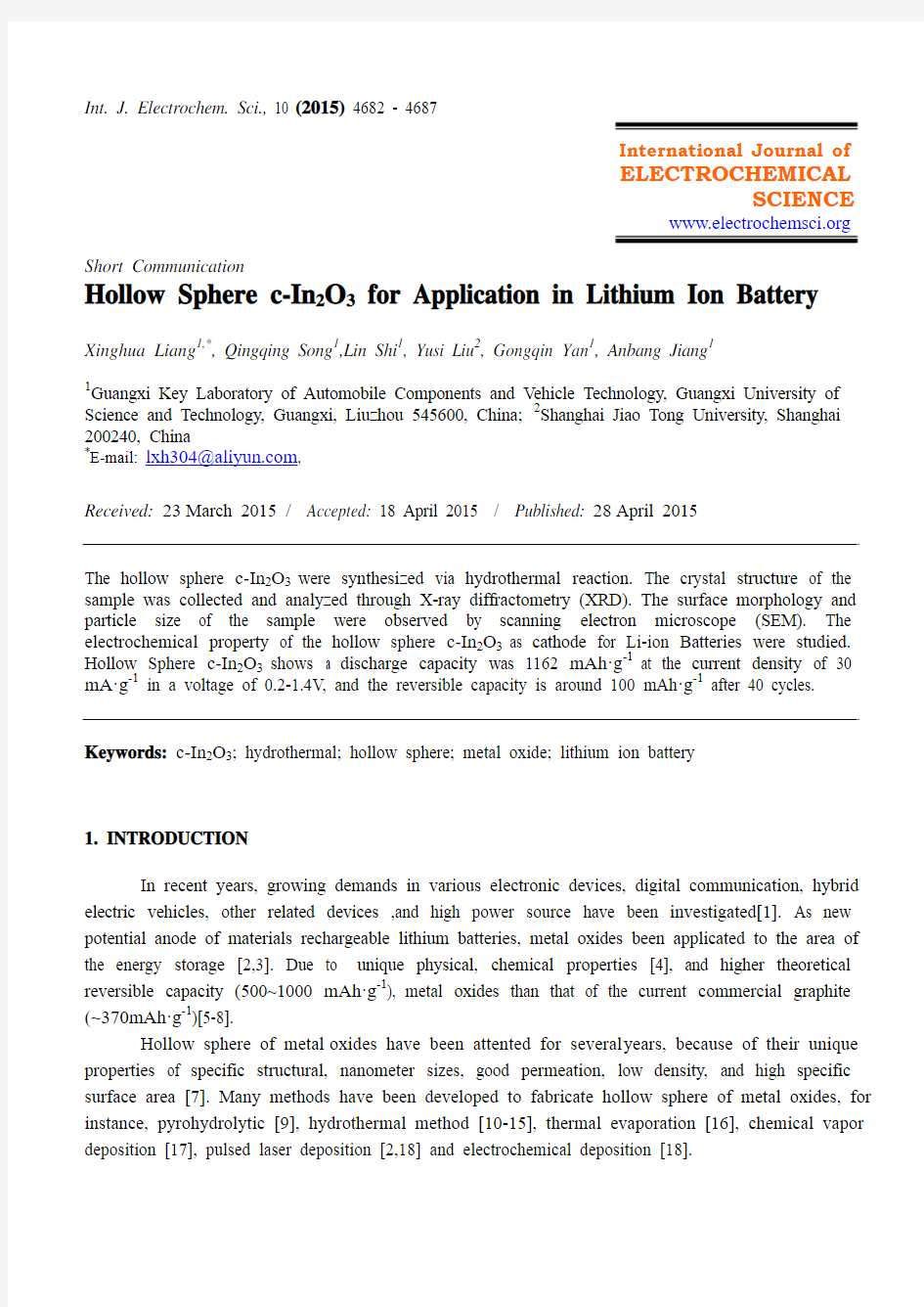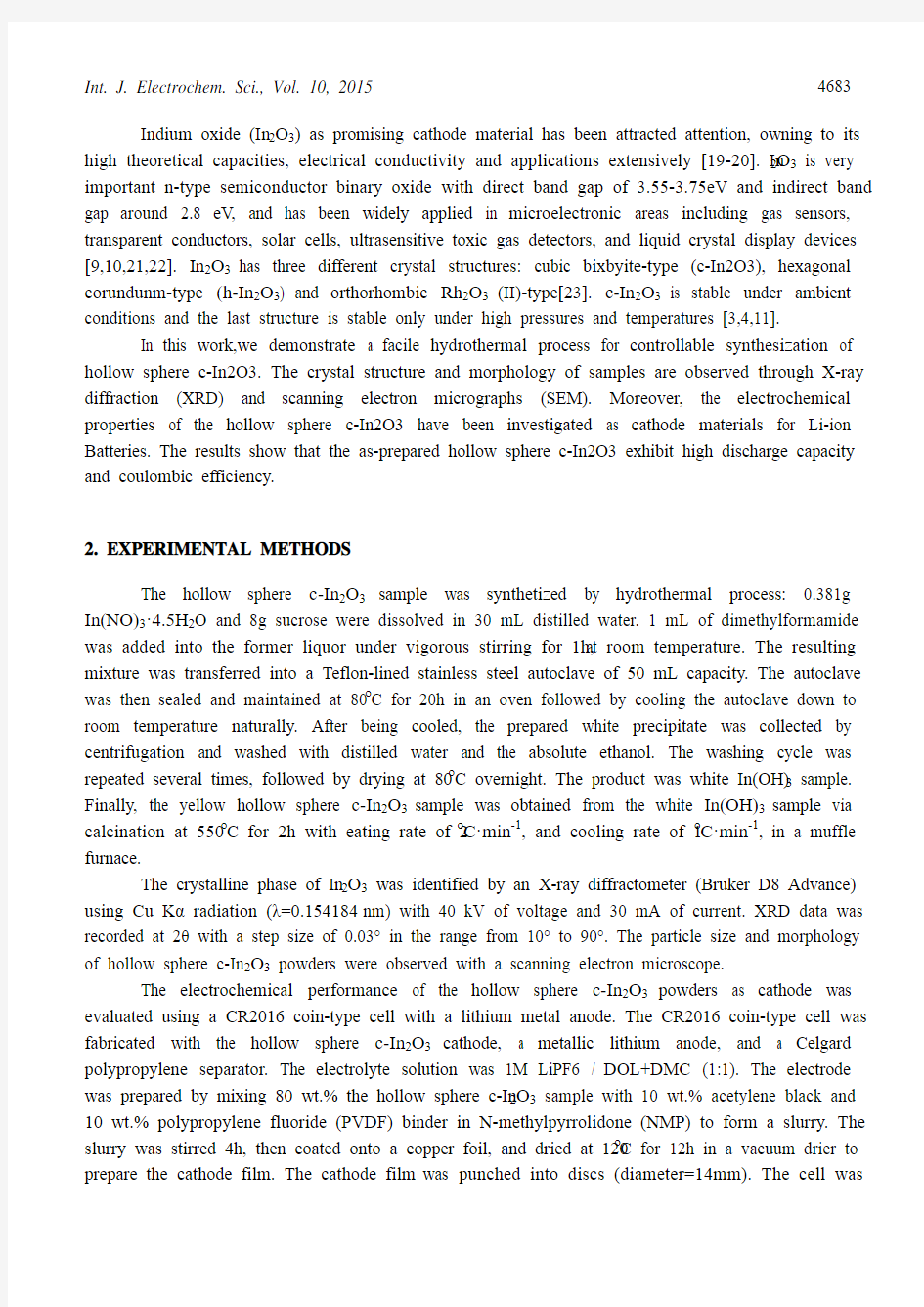水热反应法制备球壳形In2O3用于电池的阴极


Int. J. Electrochem. Sci., 10 (2015) 4682 - 4687
International Journal of
ELECTROCHEMICAL
SCIENCE
https://www.360docs.net/doc/452865282.html, Short Communication
Hollow Sphere c-In2O3 for Application in Lithium Ion Battery Xinghua Liang1,*, Qingqing Song1,Lin Shi1, Yusi Liu2, Gongqin Yan1, Anbang Jiang1
1Guangxi Key Laboratory of Automobile Components and Vehicle Technology, Guangxi University of Science and Technology, Guangxi, Liuzhou 545600, China; 2Shanghai Jiao Tong University, Shanghai 200240, China
*E-mail: lxh304@https://www.360docs.net/doc/452865282.html,,
Received: 23March 2015/ Accepted: 18 April 2015 / Published: 28April 2015
The hollow sphere c-In2O3were synthesized via hydrothermal reaction. The crystal structure of the sample was collected and analyzed through X-ray diffractometry (XRD). The surface morphology and particle size of the sample were observed by scanning electron microscope (SEM). The electrochemical property of the hollow sphere c-In2O3as cathode for Li-ion Batteries were studied. Hollow Sphere c-In2O3shows a discharge capacity was 1162 mAh·g-1at the current density of 30 mA·g-1 in a voltage of 0.2-1.4V, and the reversible capacity is around 100 mAh·g-1 after 40 cycles.
Keywords: c-In2O3; hydrothermal; hollow sphere; metal oxide; lithium ion battery
1. INTRODUCTION
In recent years, growing demands in various electronic devices, digital communication, hybrid electric vehicles, other related devices ,and high power source have been investigated[1]. As new potential anode of materials rechargeable lithium batteries, metal oxides been applicated to the area of the energy storage [2,3]. Due to unique physical, chemical properties [4], and higher theoretical reversible capacity (500~1000 mAh·g-1), metal oxides than that of the current commercial graphite (~370mAh·g-1)[5-8].
Hollow sphere of metal oxides have been attented for several years, because of their unique properties of specific structural, nanometer sizes, good permeation, low density, and high specific surface area [7]. Many methods have been developed to fabricate hollow sphere of metal oxides, for instance, pyrohydrolytic [9], hydrothermal method [10-15], thermal evaporation [16], chemical vapor deposition [17], pulsed laser deposition [2,18] and electrochemical deposition [18].
Indium oxide (In2O3) as promising cathode material has been attracted attention, owning to its high theoretical capacities, electrical conductivity and applications extensively [19-20]. In2O3 is very important n-type semiconductor binary oxide with direct band gap of 3.55-3.75eV and indirect band gap around 2.8 eV, and has been widely applied in microelectronic areas including gas sensors, transparent conductors, solar cells, ultrasensitive toxic gas detectors, and liquid crystal display devices [9,10,21,22]. In2O3has three different crystal structures: cubic bixbyite-type (c-In2O3), hexagonal corundunm-type (h-In2O3) and orthorhombic Rh2O3(II)-type[23]. c-In2O3is stable under ambient conditions and the last structure is stable only under high pressures and temperatures [3,4,11].
In this work,we demonstrate a facile hydrothermal process for controllable synthesization of hollow sphere c-In2O3. The crystal structure and morphology of samples are observed through X-ray diffraction (XRD) and scanning electron micrographs (SEM). Moreover, the electrochemical properties of the hollow sphere c-In2O3 have been investigated as cathode materials for Li-ion Batteries. The results show that the as-prepared hollow sphere c-In2O3 exhibit high discharge capacity and coulombic efficiency.
2. EXPERIMENTAL METHODS
The hollow sphere c-In2O3sample was synthetized by hydrothermal process: 0.381g In(NO)3·4.5H2O and 8g sucrose were dissolved in 30 mL distilled water. 1 mL of dimethylformamide was added into the former liquor under vigorous stirring for 1h, at room temperature. The resulting mixture was transferred into a Teflon-lined stainless steel autoclave of 50 mL capacity. The autoclave was then sealed and maintained at 80o C for 20h in an oven followed by cooling the autoclave down to room temperature naturally. After being cooled, the prepared white precipitate was collected by centrifugation and washed with distilled water and the absolute ethanol. The washing cycle was repeated several times, followed by drying at 80o C overnight. The product was white In(OH)3 sample. Finally, the yellow hollow sphere c-In2O3sample was obtained from the white In(OH)3sample via calcination at 550o C for 2h with eating rate of 2o C·min-1, and cooling rate of 1o C·min-1, in a muffle furnace.
The crystalline phase of In2O3 was identified by an X-ray diffractometer (Bruker D8 Advance) using Cu Kα radiation (λ=0.154184 nm) with 40 kV of voltage and 30 mA of current. XRD data was recorded at 2θ with a step size of 0.03° in the range from 10° to 90°. The particle size and morphology of hollow sphere c-In2O3 powders were observed with a scanning electron microscope.
The electrochemical performance of the hollow sphere c-In2O3powders as cathode was evaluated using a CR2016 coin-type cell with a lithium metal anode. The CR2016 coin-type cell was fabricated with the hollow sphere c-In2O3cathode, a metallic lithium anode, and a Celgard polypropylene separator. The electrolyte solution was 1M LiPF6 / DOL+DMC (1:1). The electrode was prepared by mixing 80 wt.% the hollow sphere c-In2O3 sample with 10 wt.% acetylene black and 10 wt.% polypropylene fluoride (PVDF) binder in N-methylpyrrolidone (NMP) to form a slurry. The slurry was stirred 4h, then coated onto a copper foil, and dried at 120o C for 12h in a vacuum drier to prepare the cathode film. The cathode film was punched into discs (diameter=14mm). The cell was
fabricated in an Ar-filled glove box. The assembled cell was charged and discharged between 0.2V and 1.4V (versus Li/Li+) on the a multi-channel battery test system instrument at room temperature.
3. RESULTS AND DISCUSSION
Fig.1 shows a full set of diffraction peaks of the In2O3 sample. The sharp peaks in the pattern showed good crystallinity of the In2O3sample. It is seen that a few of strong peaks at the near 21.49°, 30.58°, 35.47°, 51.04°, 83.20° can be indexed to the cubic phase of c-In2O3(JCPDS no.06-0416), which is invisible in the XRD patterns[11]. The lattice parameters refined within this space group for the new phase are a=1.012nm (a=1.0118nm from JCPDS no.06-0416), and unit cell volume V0=0.065 nm3.
Figure 1. XRD pattern of hollow sphere c-In2O3
In Fig.2, it vividly reveals that the In2O3 sample consists of hollow sphere microspheres and sphere-section with a diameter of about 1-3μm. More interestingly, both the inner and outer surface of the hollow c-In2O3 sample are rough (Fig.2 a.b). The thickness o f the hollow ball is about 0.6μm. It worth noting that some of the hollow ball is incomplete. Sphere wall was structure by nanocrystals (Fig.2 c). It is well-known that rate capability plays an important role in lithium ion battery. The electrochemical performance of hollow sphere c-In2O3 were evaluated by galvanostatic measurements. Fig.3 shows that the first discharge curve of the coin cell between 0.2V and 1.4V, at a constant current density of 30 mA·g-1.
(a) (b)
(c)
Figure 2. (a) (b) SEM image of hollow sphere c-In2O3;(c) magnified SEM image of hollow sphere c-In2O3 nanoparticles of the position marked in (b).
In the initial discharging process, there is a long smooth voltage plateaus around 0.9V, and The first discharge capacity is 1162 which is higher than that report by Zhou et al[2]. However, with the increase of the cycling times, the discharge capacity of the coin cell presents a downward trend. Especially, the second discharge capacity downs quickly from 1162 mAh·g-1to 201 mAh·g-1. After the five cycle, the discharge capacity curve of the coin cell keeps a stable condition.
Figure 3. The first discharge curve of the Li/In2O3 coin cell
a b c Figure 4. Electrochemical properties of hollow sphere c-In2O3: (a) specific capacity of Li/In2O3 coin cell; (b) coulombic efficiency of Li/In2O3 coin cell; (c) rate performance of Li/In2O3 coin cell
It suggests that hollow sphere c-In2O3has large irreversible capacity. In the 40th cycle, the discharge capacity of the coin cell only remains about 100 mAh·g-1 (Fig. 4a ). The massive capacity reduction may be attributed to lithiation reaction initially and delithiation of the electrode in the lithium ion battery [5]. Coulombic efficiency is a key index for evaluating the stability of the coin cell. It can be seen that the coulombic efficiency in the first cycle is low and unstable, and becames gradually increasing from 70% to 94% (Fig. 4b),which may be due to the diffusion rate of Li+ ions in hollow sphere c-In2O3 becoming stable.As shown in Fig. 3c, it can be seen that the discharge capacity of the coin cell decreased quickly at the current density of 30 mA·g-1 during the first five cycles. When the current density gradually increased from 60 mA·g-1to 240 mA·g-1, the In2O3electrode delivered a capacity of 90 mAh?g-1, 82 mAh?g-1, 74 mAh·g-1, respectively. While the current density back to 30 mA·g-1after being continuously cycled for 10 times, a capacity of 101 mAh?g-1can be obtained,indicating good robustness and stability of hollow sphere c-In2O3 material.
4. CONCLUSION
In conclusion, the hollow sphere c-In2O3sample was prepared by hydrothermal method. According to the XRD and SEM, sample was cubic bixbyite-type structure (Ia-3) In2O3, good crystallinity and hollow sphere. The sample presented the larg e discharge capacity of 1162 mAh·g-1 at the current density of 30 mA·g-1 between 0.2V and 1.4V. The discharge capacity faded quikly in the charge-discharge process. After 40 cycles, the reversible capacity was around 100 mAh·g-1, and coulombic efficiency rises to 94%.
ACKNOWLEDGEMENTS
This work was financially supported by the Building Fund (No.13-051-38) and Opening Project of Guangxi Key Laboratory of Automobile Components and Vehicle Technology (No.2012KFMS04, 2013KFMS01).
References
1.K.R. Prasad, K. Koga and N. Miura, Chem. Mater, 16 (2014) 1845.
2.Y.N. Zhou, H. Zhang, M.Z. Xue, C.L. Wu, X.J. Wu and Z.W. Fu,J. Power Sources, 162 (2006)
1373.
3. D. Liu, W.W. Lei, S. Qin and Y. Chen, Electrochim Acta, 135 (2014) 128.
4. D. Liu, W.W. Lei, S. Qin, L.T. Hou, Z.W. Liu, Q.L. Cui and Y. Chen, J Mater Chem A , 1 (2013)
5274.
5.L. Zhao, W.B. Yue and Y. Ren, Electrochim Acta , 116 (2014 ) 31.
6.S. Qin, W.W. Lei, D. Liu, P. Lamb and Y. Chen, Mater Lett, 91 (2013) 5.
7.H. Li, X.J. Huang and L.Q. Chen, Solid State Ionics, 123 (1999) 189.
8.X.H. Huang, J.P. Tu, B. Zhang, C.Q. Zhang, Y. Li, Y.F. Yuan, et al. J. Power Sources, 161 (2006)
541.
9.W.H. Zhang and W.D. Zhang, J Solid State Chem, 186 (2012) 29.
10.B.X. Li, Y. Xie, M. Jing, G.X. Rong, Y.C. Tang and G.Z. Zhang, Langmuir,22 (2006) 9380.
11.H.X. Yang, L. Liu, H. Liang, J.J. Wei and Y.Z. Yang, CrystEngComm, 13 (2011) 5011.
12.X. He, H.R. Liu, H.L. Dong, J. Liang, H. Zhang and B.S. Xu, J Inorg Mater, 29 (2014) 264.
13.X. Yang, J. Xu, T.L. Wong, Q.D. Yang and C.S. Lee, Phys Chem Chem Phys, 15 (2013) 12688.
14.M.M. Titirici, M. Antonietti and A. Thomas, Chem Mater, 18 (2006) 3808.
15.J. Yang, C.K. Lin, Z.L. Wang and J. Lin, Inorg Chemi, 45 (2006) 8973.
16.M.A. Mahdi, J.J. Hassan, S.J. Kasim, S.S. Ng and Z. Hassan, Mat Sci Semicon Proc, 26 (2014) 87.
17.Q.Y.Wang, K. Yu, F.Xu, J.Wu, Y.Xu and Z.Q. Zhu, Mater Lett, 62 (2008) 2710.
18.T.G. Kim, H.B. Oh, H. Ryu and W.J. Lee, J Alloy Compd, 612 (2014) 74.
19.R.Yang, J.Zheng, J.Huang, X.Z.Zhang, J.L.Qu and X.G.Li, Electrochem Commun, 12 (2010) 784.
20.W.H. Ho, C.F. Li, H.C. Liu and S.K. Yen, J. Power Sources, 175 (2008) 897.
21.Y.W. Hu, W. Zhang and W. Pan, Mater Res Bull, 48 (2013) 668.
22.Z.M. Li, P.Y. Zhang, T. Shao and X.Y. Li, Appl Catal B-Environ, 125 (2012) 350.
23.D. Liu, W. W. Lei, B. Zou, S. D. Yu, J. Hao, K. Wang, B. B. Liu, Q. L. Cui and G. T. Zou, J. Appl.
Phys., 104 (2008) 083506.
? 2015 The Authors. Published by ESG (https://www.360docs.net/doc/452865282.html,). This article is an open access article distributed under the terms and conditions of the Creative Commons Attribution license (https://www.360docs.net/doc/452865282.html,/licenses/by/4.0/).
